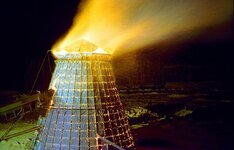- Messages
- 387
- Reactions
- 433
Follow along with the video below to see how to install our site as a web app on your home screen.
Note: This feature may not be available in some browsers.
Everything is about the money…. just another environmentalist group using emotional language and moving the "goal posts". They use vague terms with no data sources to actually advocate letting forests burn up in wildfires rather than to harvest trees. Then when the trees are harvested it's not the trees of their liking being replanted…. and proper clear cutting doesn't "strip all life" from the area.It's all about the money.
The Myth of Replanting: 5 Ways Oregon’s Laws Destroy Forests
Here in Oregon, a little less than half of the land is forested. Almost all of that forestland is owned either by private timber companies, the State of Oregon, or a federal agency such as the U.S. Forest Service, or the Bureau of Land Management. In Western Oregon, there are two very different...oregonwild.org
My assumption is, trees are left close together so as the trees grow lower limbs don't develop enough to make knot-holes. Knot holes are not a good thing for finished lumber.Can someone explain reprod to me.
why is it so thick?
If they do, when do they do thin it out and why.
Waste product from timber manufacturing.This thread was not what I expected. Pretty sad stuff. I dumpster dived into Oregon's "green energy" recently and found that we like many other area in the US are now using "bio mass" to fuel the energy grid. What's "bio mass" you ask? It's trees.
Edited to add that biomass only makes up 1.5% of the states total energy grid, but the number of facilities grew over the last 5 years. Most if not all of them are owned by timber companies.

A squaw!!Waste product from timber manufacturing.
Not sure if you are old enough to remember when they just burned it. I am. They looked like miniature volcanoes.
View attachment 1012720
Sort of the same, now it just boils water.Waste product from timber manufacturing.
Not sure if you are old enough to remember when they just burned it. I am. They looked like miniature volcanoes.
View attachment 1012720
If the trees are poplar, then yeah, they may grow them for biomass. But they are not going to grind up trees that can be used for dimensional lumber. No mill will accept my maple or alder trees - it costs too much to haul these "weed" or "junk" trees to the mill to make it profitable. So the loggers just stack them into slash piles to burn them on site. It is usually up to the landowner to either burn them or leave them as they are, mostly they get burned. I burned about half mine. The rest were too close to standing timber to risk burn. I have other stacked logs that I have tried to give away as firewood but no one will come cut them up, so they are mostly laying there slowly rotting.Sort of the same, now it just boils water.
The claim they only use the waste, but they don't. When needed, they just grind up whole trees and burn them. They use terminology like "wood chips" to give the public a sense like it is a byproduct of cutting lumber, but in reality it can actually be whole trees ground up and burned. In some counties, they even consider tire mulch "bio mass" and burn it because it came from "natural" sources.
I know it's completely off topic, but it just boggles the mind what we are doing to the forests.
Trees produce a lot of seeds. In a natural forest system, most of them would not survive. Lightning strikes would start small fires that would keep the forest floor clean of debris and kill most seedlings, while larger, mature trees would be protected by their thick bark. These small fires would burn themselves out in a relatively short period of time. The result would be a mature forest with widely spaced adult trees with limited reproduction. (There is also a factor called forest succession which for simplicity's sake I won't get into). Prior to the arrival of Europeans, Native Americans would also set fires each year to clear the forest floor of brush to improve visibilty for hunting.Can someone explain reprod to me.
why is it so thick?
If they do, when do they do thin it out and why.
Yup - I am 67 and I was so young that I barely remember them on our trips to/from the coast, but I do remember them. I think I remember some from my teens (?) at the mills in the Lyons/Mill City area, but I think they mostly went out of use in the early 70s or before.Once a icon of 'mills', the ubiquitous teepee burner, don't think you will find any actively used today. Most have been 'decommissioned in favor of the production of chip (particle) board (OSB) used to support the housing 'industry". Glue and wood burns quickly! Ever wonder where the Aspen trees in Colorado have gone?
In case you didn't glean it from my posts, I am a timberland owner.Lmao. I thought this was a pacific northwest forum. Ya'll must be a bunch of cubicle dwellers. Sorry, I worked in the woods my whole life, my paycheck still comes from natural resource extraction. Go check out Hancock timber resources group, they own vast acreage of timberland in eastern Oregon, Washington, Idaho and Montana,. Go drive through their lands, then drive through blm or forest service land, one is being managed for timber production, the others are a fire waiting to happen.